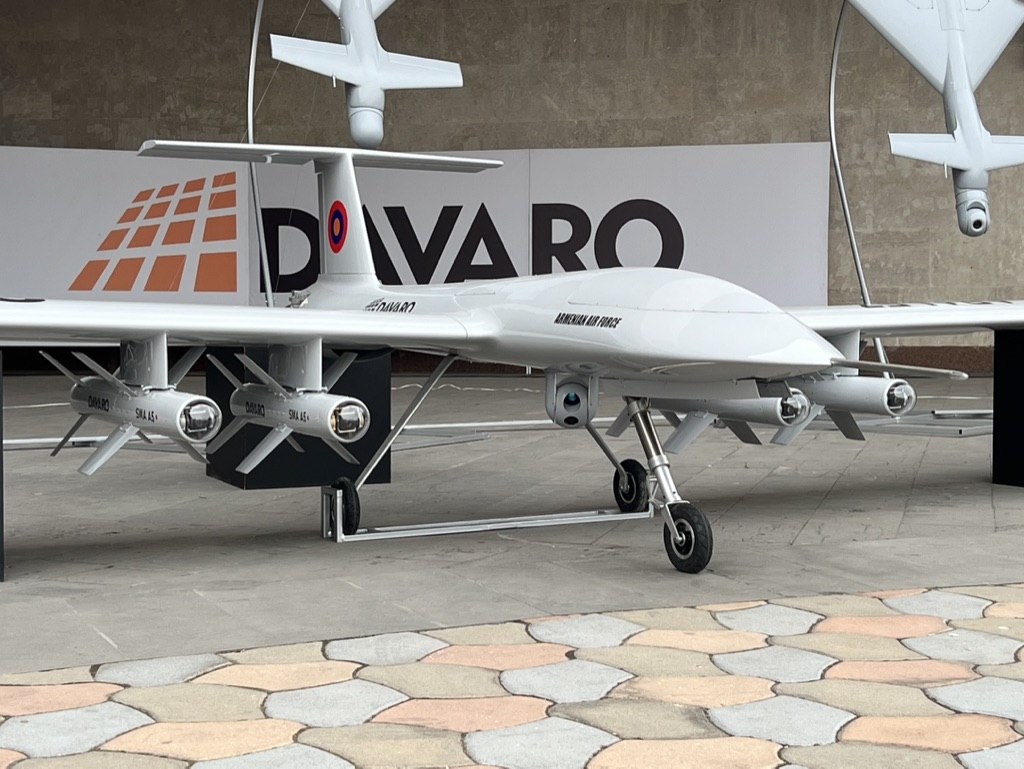Flood the Zone With Cheap Drones
Ukraine needs more drones. How can the U.S. best supply them?

Published by The Lawfare Institute
in Cooperation With

The U.S. government has provided substantial support to the Ukrainian military since the Russian invasion, including supplying Ukraine with sophisticated rocket systems, artillery pieces, surface-to-air missiles, and a host of other items totaling billions of dollars. With the war in Ukraine entering a sustained phase, the U.S. should not only maintain this stream of aid to Ukraine but also develop and provide new systems specifically tailored to the nature of the ongoing conflict.
In particular, the U.S. military can design and manufacture low-cost suicide drones (also known as “loitering munitions”) for transfer to the Ukrainian military. A suicide drone is a small drone that can be remotely controlled to crash into a target, giving a precision-strike capability to anyone who can launch such a drone. This could both support Ukrainian forces and serve as a valuable exercise for the U.S. military’s own innovation capabilities.
The continuing footage provided by small drones in the Ukraine area suggests an exploitable problem with Russian electronic warfare capabilities. These small drones are remote controlled, and the Russians seem to be neither effectively jamming nor attacking the drones’ controllers with artillery fire. This suggests a stunning deficiency in Russian military operations, one that the Ukrainian military—with quickly deployed foreign systems—should be able to further exploit.
The U.S. has already begun to supply “low cost” Switchblade drones—small suicide drones with an explosive payload. The payload in these drones is not much, roughly equivalent to a 40 millimeter (mm) grenade. The U.S. military has agreed to deliver 700 Switchblade 300s, which at an estimated $6,000 each, represents an investment of over $4 million. The Switchblade itself is fairly sophisticated: It is launched from a portable tube launcher, and, after a target is selected, it flies into the target and explodes just before impact.
But the key aspect is that a small explosive warhead, a mere 200 grams for a 40 mm grenade (just 33 percent heavier than a baseball), is remarkably effective when combined with the precision of a drone. Consider a long-ranged howitzer weapon and its crew. An artillery shell with 10 kilograms of explosive that lands 100 meters from the target will do less damage to personnel and equipment compared to a simple grenade delivered by a drone to explode on top of the gun’s breech.
But “low cost” by U.S. military standards is still too expensive for supporting Ukraine in a war where Russia is firing 60,000 artillery shells per day. The Ukrainian military needs systems that are actually low cost, not “low cost” by our standards. It needs suicide drones that cost $500, not $6,000.
Given the permissive electronic warfare environment, it is reasonable to crash develop and deploy, en masse, such inexpensive systems with a range of more than 4 kilometers and a lethal payload equivalent to that of the Switchblade. A $10 million budget could then flood Ukraine with 19,000 easy-to-use suicide drones (at roughly $500/drone) and 1,000 ground stations (at roughly $500/station). Basically 10 times the drones for the same amount of money. Such a design need not rely on outside contractors but could use in-house U.S. military expertise to design and build.
How can one design such drones?
One begins with an airframe. The Switchblade uses a custom airframe in order to be launched from a tube. But if the operators are willing to throw the drone into the air by hand or use a giant rubber band, there are much cheaper alternatives.
The design would start with a medium-sized model airplane, such as this polypropylene foam fixed-wing design ($200), which is made out of the same material you find in car bumpers and can easily carry a grenade’s worth of payload.
Such drones need power, but a rechargeable high-capacity battery costs just $60. This should provide sufficient endurance for a half hour of flight. It then becomes simply a matter of developing a control system. Later on one could add some low-cost autonomy (something I’m working on myself in my new start-up). But if the U.S. wants to ship something today, it should be purely human controlled.
The components necessary for human control already exist, such as this long-range receiver with basic stabilization ($40). Stabilization routines make the drone remarkably easy to fly, as it operates under the same “fly-by-wire” logic present in a modern airplane: Instead of the inputs directly controlling the drone, it translates “pilot intent.” This also means a loss of communication can put the drone into a mode where it just continues to fly in a straight line. If the operator lines up a drone on a nonmoving target, subsequent jamming from an adversary won’t stop the drone’s impact. Thus any jamming must be accomplished before the operator lines up for an attack.
To complete the system, add a camera ($50) and a video transmitter ($50)—which allows the pilot to see from the drone’s viewpoint. Then 3D print an internal frame and add whatever $10 servo (a small electrically controlled motor) is needed to arm the explosives. Hit the drone with a coat of sky-blue spray paint, install the warhead, and the drone is complete. Total cost, excluding the warhead, should be roughly $500. Now all that is needed is a ground station to control the drone—which would include a standard hobby radio ($200), a transmitter module ($65), a video receiver ($90), and a battery charger ($70).
Such a system would require almost no training: The airframe is easy to assemble in the field (just attach the wings, pair the receiver, power the drone, and arm the warhead); it is hand launched; and the stabilization routines in the receiver make it easy to fly. A few hours of training should be sufficient (especially given the video-game reflexes of the modern generation). And existing drone simulation software can be modified to further enhance training.
Initially in the rush to field systems, it makes sense to use standard transmitters. But in the long run, this represents a vulnerability: A radio transmitter can be detected and targeted. Subsequent revisions need to make some changes. Fortunately the design of the radios will make revisions to the transmitters relatively easy, as the actual transmitter that broadcasts the controls is a distinct component and can therefore be swapped out without too much trouble.
When making operational improvements to the transmitter, instead of installing the transmitter module directly in the radio, it would be necessary to design and fabricate a relay module. This would consist of two pieces—one in the radio and one connected to the transmitter—linked by a long wire. This way the soldier’s transmitter would be a significant distance from the drone itself, reducing the ability of a competent adversary to direct accurate fire onto the transmitter.
Designing drone systems in this way is clearly not “military grade” engineering. Instead it is cheap and, truth be told, janky engineering. But an enemy soldier is no less dead if the 200 gram explosive payload is delivered by something cobbled together from the hobby market rather than built through quality engineering. The goal is simply to effectively deliver the payload to the target as cheaply as possible.
Who should design and build these systems?
Once military contractors get involved, the price multiplies exponentially. This would eliminate the cost savings and probably increase the time to market. Fortunately, however, the U.S. military has the resources to design and build such drones in house without needing to rely on contractor support.
For example, the Air Force has a series of innovation labs at bases throughout the country. One such lab at Travis Air Force Base, the Travis Spark Lab, has the necessary resources and internal expertise—including experience with small drones and additive manufacturing. Additionally, the military academies could use this as an exercise for their senior engineering students, all of whom should be up to this task.
Provide this as an assignment to the personnel at Travis and the cadets at the Air Force Academy in Colorado Springs, give each team a $20,000 prepaid credit card to order the necessary materials, and they could probably be flying in a week, refined in two, and shipping in three. Even better it could be a contest: Four Teams (Travis, Colorado Springs, the Military Academy at West Point, and the Naval Academy at Annapolis), Three Weeks, One Mission.
By the end there would almost certainly be at least one if not four fieldable systems.
Then to continuously refine the systems, the U.S. should settle into a repeating cycle of design, produce 500, and ship to Ukraine. This would not only act to support Ukraine with a substantial number of otherwise unavailable precision resources, but it would also serve as a test and—hopefully—demonstration that the U.S. military’s innovation labs have the capacity, in house, to provide capabilities at a price that no contractor could match.
All that would be left to do would be monitoring and improving the airframes and the electronics based on tests and feedback from the Ukrainian customer base. Changes might include encrypting transmitters to prevent hijacking, switching airframes to deal with supply chain limitations, the addition of optional psychological effects (such as a version of a Stuka’s siren), switching from an integrated warhead to a design using a reloadable 40 mm grenade launcher, or other changes as driven by customer demand.
The ability of such drones likely won’t last forever. If Russia is willing to deploy broad-spectrum electromagnetic (EM) jamming (which would most likely disrupt their own small drones), it can stop the attack. Quick EM triangulation could identify the transmitters as well, though the transmitters should eventually be placed well away from the actual controllers using relay modules—which would largely negate the threat posed by EM triangulation. But until Russian forces bolster their EW capabilities, they would face a swarm of lightweight drones.


.jpg?sfvrsn=e915b36f_5)


